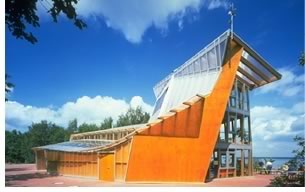

Learn Something New: e-Classroom Debuts Three More Distance Learning Courses
 This
week, AIA eClassroom added three more new distance-learning courses—all
offering health-safety-welfare credits—to its repertoire from the
2003 AIA National Convention. Meet the AIA Top Ten Green Buildings of
2003, get an architect’s perspective on the NFPA 5000 Building Construction
and Safety Code, and find out why two prominent construction lawyers say,
“Owner-Drafted Agreements, Sign Here Stupid!” The three new
courses are:
This
week, AIA eClassroom added three more new distance-learning courses—all
offering health-safety-welfare credits—to its repertoire from the
2003 AIA National Convention. Meet the AIA Top Ten Green Buildings of
2003, get an architect’s perspective on the NFPA 5000 Building Construction
and Safety Code, and find out why two prominent construction lawyers say,
“Owner-Drafted Agreements, Sign Here Stupid!” The three new
courses are:
"Green by Design: AIA Top Ten”
(FR16)
See this year’s AIA Top Ten Green projects, chosen by jury to illustrate
an integrated design process and use of performance metrics. The program
also explains how firms can submit winning projects.
You’ll:
- Understand the impact of the built and natural environment
- Gain insight into whole-building design approach
- Learn about resources and tools for sustainable design
- Learn about AIA COTE and related U.S. Department of Energy programs.
Teaching this course is a diversified panel of experts: Mark Ginsberg, Energy Efficiency and Renewable Energy board director and former deputy assistant secretary for the Office of Building Technology, State and Community Programs (BTS); Joyce Lee, AIA, chief architect, New York City Office of Management and Budget; Dan Williams, FAIA, principal of Daniel Williams ARCHITECT and an urban and regional designer and 2003 chair of the 2003 AIA Committee on the Environment; and Sandra Mendler, AIA, vice president and sustainable design principal of Hellmuth, Obata + Kassabaum, Inc.
For more information, visit the eClassroom site. ![]()
"Owner-Drafted Agreements, Sign Here
Stupid!" (SA07)
Many firm owners are drafting their own version of an owner-architect
agreement that is often one-sided and may disregard the traditional owner-architect-contractor
roles and responsibilities found in standard AIA Documents, say the teachers
for this course. Learn how to navigate the pitfalls.
Specifically, you’ll learn:
- What to look for and where the red flags are
- How to manage negotiations to present your position and educate owners
- What is an unacceptable position and a potential deal breaker.
Teaching this course are John H. Baker, Esq., AIA, Northwest & Pacific director on the AIA Board and lawyer with Jordan Schrader, and Michael K. De Chiara, Esq., a partner in Zetlin & De Chiara LLP and general counsel to AIA New York State.
For more information, visit the eClassroom site. ![]()
“The NFPA 5000 Building Construction
and Safety Code: An Architect’s Perspective” (TH12)
This course will allow you to focus on the design, features, organization,
and content of the newly developed NFPA 5000 Building Code, recommended
July 29 by the California Building Standards Commission for use in the
state’s buildings. It clarifies the goals and objectives that form
the basis of code requirements for safety, health, building usability,
and public welfare.
You’ll learn to:
- Understand the basis for rationally conceived code requirements
- Navigate the code, organized by occupancy
- Use available performance and prescriptive approaches to code compliance
- Become familiar with increased options for the effective rehabilitation of existing buildings.
The instruction for this course is Nancy McNabb, AIA, regional manager of NFPA International’s Building Code, Dallas.
For more information, visit the eClassroom site. ![]()
Copyright 2003 The American Institute of Architects.
All rights reserved. Home Page ![]()
![]()
 |
||
| The cost per program is $99.95 AIA members, $149.95 nonmembers. Each program offers two health-safety-welfare learning units. For a complete list of eClassroom offerings, visit the eClassroom Web site. And check out eClassroom’s Web site improvement—it’s easier than ever to use! Pictured is the Steinhude SEA Recreation Facility, Los Angeles, by Randall Stout Architect, a 2003 Top Ten Green project.
|
||